A finished crossing
July 3, 2015 10:02 am Leave your thoughts
As I explained in my first blog, my job this summer, as a Roads Summer Student will be to inspect and remediate water crossings, for example, culverts and bridges. It is critical that these be installed correctly and maintained throughout their lifespan, to protect sensitive riparian habitats.
As you can see, this crossing now looks very different from the photo included in my first blog. The sharp banks have been pulled back, and the road has been smoothed out to create a gentle slope going down to the stream channel.
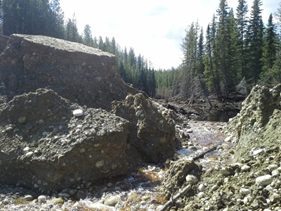 |
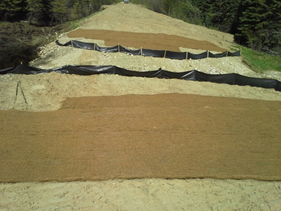 |
The beige material in the foreground and background of the “after” photo is coco-matting that is used primarily to hold grass seeds in place, letting them sprout and grow roots without washing away. All of the bare soil around this crossing has been seeded with grass seeds, all the way up to the furthest cross ditches from the stream channel (cross ditches divert water that is running along the road surface into the bush on either side of the road, preventing it from flowing directly into bodies of water, such as this stream).
On either side of the stream channel is black silt fencing. Silt fences are made of a tightly woven material that allows water to slowly pass through but filters out most of the soil particles that might be in the water. Until the grass seeds sprout and establish, holding the soil in place, these silt fences will keep any road material or soil from washing away into the stream. Silt fences have to have the bottom 6” or so dug underground, and buried, so that water full of sediment cannot seep underneath the fences, rendering them useless.
Once grasses and other plants have established, these silt fences are no longer necessary but will be left in place to minimize site disturbance. Hopefully with the rain this weekend, our grass seeds will be able to sprout, preventing any erosion or sedimentation issues.
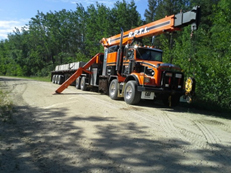
The final step of all the work on this crossing was to place cement blocks on either side, blocking vehicles from driving down to the stream. This was completed with the help of a couple of contractors with a picker truck. With me providing location guidance, they unloaded the blocks across the road. We had the blocks placed in such a way that pickup trucks and other traffic can’t get through, but quads and smaller UTVs are able to sneak past in the ditches.
In the picture below, you can see that a quad would fit nicely on the left side, but other vehicles wouldn’t be able to. The blocks are about a meter wide, for scale.
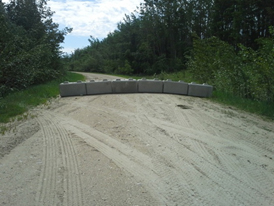
Now that everything is done, all that we need to do is to check on our handiwork every once in a while, especially in these next few weeks when the grass is getting established.
I haven’t gotten up in a helicopter yet this summer. Instead, I have been doing road inspections from the ground, which let you see roads in better detail than you could from the sky. I have also done a few crossing inspections as I have been going along, but I have yet to begin with the main crossing inspection program for the summer. I have also been out speed monitoring log trucks these past couple of weeks, to ensure that they are obeying posted speed limits.
I wish I could tell you what I will be up to over the next two weeks, so that you will have something to look forward to while waiting for my next blog post, but I can’t. Two weeks is a long time, and plans can easily change. You’ll just have to check for my third blog in two weeks to find out what I’ve been up to. Thanks for reading!
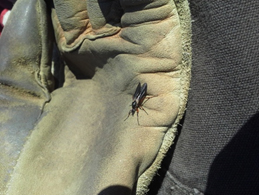
Postscript: if anyone knows what kind of insect this is, would you please comment on this post and let me know? They seem to enjoy swarming me whenever I stop in areas with sandy soils, but I have yet to be bitten, so I think they are harmless, although annoying. I’m curious to find out what they could be.
